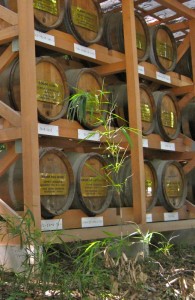By Takeshi Okimura
An array of wine barrels placed at the front approach to Meiji Shrine in a wooded area of Shibuya Ward, Tokyo, serves as tangible proof that the beverage has created strong ties with France and served as a bridge for cultural exchange.
To mark the 10th year this year of wine being sent from France, 10 Meiji Shrine priests and maidens will perform court music and dance in Paris and Burgundy beginning Friday. They usually perform on wind and string instruments and dance in a Shinto ritual.
In connection with Emperor Meiji, who promoted embracing many features of Western culture and, in particular, enjoyed wine, the wineries in Burgundy — the No. 1 wine-producing area in France, rivaling Bordeaux — dedicate their product to the shrine every year.
-

Copyright Yomiuri Shinbun: Meiji Shrine maidens and others practice court music and dance for a performance in France on Monday at Meiji Shrine in Shibuya Ward, Tokyo.
About 180 bottles of wine are gifted from about 60 wineries every December from Burgundy, with luxury brands such as Romanee-Conti included on some occasions.
Sukehiro Hinonishi, who served as a chamberlain to Emperor Meiji, wrote in a memoir that the Emperor was very fond of wine. During that period’s time of civilization and enlightenment, the Emperor proactively assimilated Western food and clothing, and he often enjoyed drinking wine.
After having food and drink with an Imperial Household minister, the Emperor returned to the Imperial Palace and shared a drink with an aide until around 3 a.m., the memoir states. The Emperor sometimes stopped at several places for a drink.
To celebrate the marriage of his sixth daughter, he urged the Empress to ask to have wine poured into her glass, according to the memoir. Another aide also recorded that the Emperor usually had red wine at supper.

The grand torii of Meiji Jingu, the largest of its style in Japan and rebuilt in 1975 with ‘hinoki’ wood from Taiwan. (photo by John Dougill)
In the Meiji era (1868-1912), wine became popular in the Imperial Court and among high-ranking government officials. At the time of the 1877 Satsuma Rebellion, a samurai revolt also known as the Seinan War, the Imperial Family gifted wine to injured soldiers.
Meiji Shrine welcomed a proposal by Yasuhiko Sata, representative of the House of Burgundy in Tokyo and owner of the Chateau de Chailly Hotel-Golf, who took the initiative to arrange wine donations from French wineries. Donations began in 2006.
Representatives of the Confrerie des Chevaliers du Tastevin, a French historical organization to preserve the culture and history of wine, visit Meiji Shrine every year for the dedication ceremony. The dedicated wine bottles are brought to the main building of the shrine and placed there with solemnity, and then a Shinto ritual is conducted for the dedication.
The wine is offered at the Emperor Meiji Memorial Ceremony on July 30 — the anniversary of the Emperor’s death. And on the day of the Grand Shinto Ceremony commemorating the Anniversary of Emperor Meiji’s Birthday on Nov. 3, the wine is served to guests from abroad.
In front of the wine barrels placed in the precincts of Meiji Shrine, sake barrels are placed across the entrance path. “We’d like to think of Emperor Meiji, who promoted internationalization, and cherish the exchange with France while upholding Japanese tradition,” said the deputy chief priest of the shrine, Shigehiro Miyazaki.
■ Meiji Shrine
The shrine is dedicated to the spirits of Emperor Meiji and his wife, Empress Shoken. In the Edo Period (1603-1867), the site had belonged to the Kato family and Ii family, both feudal lord families. In the Meiji era, the shrine was built in 1920 at the site and the inner garden, or Yoyogi Gyoen, which came under the control of the Department of the Imperial Household. The shrine has received the most visitors of any shrine in Japan on New Year’s Day since 1980. During the first three days of this year, about 3.14 million people visited the shrine.


Leave a Reply